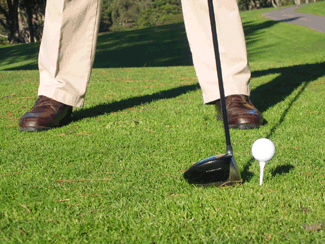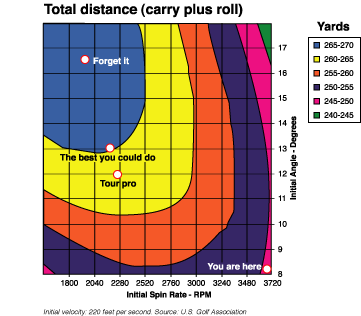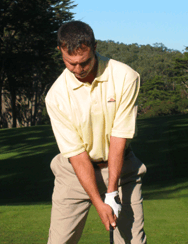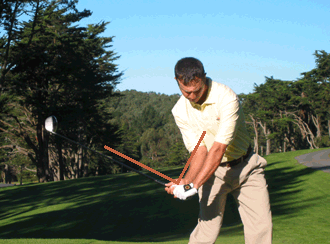Full Swing Tips - Max Out Your Ball Created on 2/1/1999 12:00:00 AM
Max Out Your Ball
Increasing your launch angle and decreasing your spin rate will help you hit it farther
You can hit your drives15 yards farther than you hit them now, using your current ball and without marking big changes in your swing or your physical conditions. This sounds too good to be true, you say? It can be done, Just launch the ball higher with less backspin.
It all comes down to something called “ launch conditions” and making them fit the ball you use.
Launch conditions refer to how the ball comes off your clubface. For distance, there are three launch conditions that matter (1) how fast the ball is going (initial velocity), (2) how much backspin it has (spin rate) and (3) its angle upward (launch angle).
Initial velocity depends on how fast you swing the clubhead. You can’t increase that very much without making substantial changes in your swing or strength. So here we’ll focus instead on your spin rate and your launch angle.
Research by ball companies and the U.S. Golf Association shows that, to make a ball go its farthest at any given swing speed, there is an optimal spin rate and launch angle. The graph on the opposite page shows how this works for a ball hit with a clubhead speed of approximately100 miles per hour – about the same as that of a short-hitting tour pro.
Without even knowing how you hit the golf ball, we can tell you right now: You’ll hit it farther if you can launch it higher with less backspin. Just look at the graph. Right now, if you’re an average player, you probably launch the ball at about 9 degrees, with 3,700 rpm of backspin or more. If you hit pop-ups, you may have a higher launch angle, but your backspin rate probably exceeds 5,000 rpm. By comparison, Tiger Woods and other PGA Tour long hitters launch it at more than 11 degrees about 2,200rmp. The monster long ball champions of the world, who sometimes jack the ball more than 400 yards, get up to 13 degrees or more launch angle, with less than 2,00 rpm. And even Tiger and the monster hitters would hit farther if they could increase their launch angles and decrease their spin rate.
So why don’t they? Because increasing your launch angle and decreasing your spin rate, while most of us can do it, isn’t without it dangers. Here we’ll give you some advice on how to hit it 15 yards farther – and some warnings about what could happen if you go too far.
Meanwhile, remember the concept of “launch conditions.” In years to come, you’ll be hearing more and more about them. They’re the key to finding their right equipment – both balls and clubs - for your game. And they can even help you find the right swing
 |
| To increase your launch angle, tee the ball much higher and well forward in your stance, Be sure to keep your shoulders square at address |
1. Use a less-lofted driver. This is the easiest way to lower the spin rate of your drives. Super long hitters often use drivers with 6 degrees of loft or less. Of course, without making other changes, you’ll also hit the ball lower, which you don’t want to do, That’s why you also need to follow advice (2), (3) and (4), below Danger: the less backspin you put on the ball, the more sidespin you could put on it. The results might be bigger hooks and slices.
2. Tee the ball farther forward in your stance. We’re talking an inch or even two ahead of your front foot. This helps you launch the ball higher, because you’ll be contacting it on the upswing. Danger: (A) Moving the ball forward can lead you to open your shoulders at address – a recipe for slicing. Make sure you keep your shoulders parallel to the target line. (B) Playing the ball forward can lead you to swing “over the top” (out to in) to make contact. This results in glancing blows, downward hits, slices and pulls.
3. Tee the ball higher. Much Higher. This is necessary to achieve high launch angles without more backspin, and allows you to hit the ball on the extreme upswing, This may require that you buy extra-long tees of three inches or more. You can even experiment with teeing the ball on a scoring pencil try to make contact with the ball on the upswing, just below its equator. Danger: If you make a steep, or upright, swing at the ball when it’s teed this high, you’ll just pop it up. And if can be difficult at first to make solid contact with the ball this high. A flatter, more around-body swing will promote consistent contact without popping the ball up.
 |
| This graph shows how to hit a given ball 20 yards farther without increasing your swing speed - just by changing your launch conditions. In this case, the initial velocity of the ball is kept constant, matching a clubhead speed of about 100 miles per hour – a little less than that of the average PGA Tour player. As the chart indicates, the higher the launch angle and the lower the spin rate, the farther the ball will go. An average player meets the conditions in the lower right-hand portion of the graph: 9 degrees or less launch angle and 3,600 revolutions per minute or more. According to scientist, the optimum combination of spin rate and launch angle consistently achievable by the best players today is approximately 1,800 rpm at 13 to 14 degrees launch angle. That explains why a tour player swinging this fast can hit this ball up to 270 yards, while an average player, swinging at the same speed, will hit it only 250. it all comes down to maximizing your initial launch conditions. |
4. Set up with your right shoulder lower and your weight a bit more on your right side. Again, this is to encourage you to hit the ball on the upswing. Danger: (A) Because you start with more weight on your right side, you may not make a good weight shift. You still need to shift your weight to your right side on the backswing in order to have an athletic weight shift back to the left side on the downswing, Be sure not to let your weight get to the outside of your right foot on the backswing, or you’ll lose balance. (B) Your swing has a tendency to follow your eye line, if you lower your right shoulder without adjusting your head position. You’ll tend to swing across the ball, producing a weak, glancing blow. Make sure your eyes are parallel to your shoulder plane.
5. Increase the lateral move of your left hip toward the target on the downswing. With the ball forward in your stance, you must exaggerate this move. Be sure your upper body stays back through impact. Studies have shown that tour players have a side bend (tilting the spine away from the target) of 30 degrees at impact. You must have least that amount with the
 |
| Setting up with your right shoulder well below your left leads to a powerful ascending blow through the ball. |
ball position. Danger: (A) If you rotate your hips with out the lateral move, your clubhead will approach the ball from outside the target line, again producing a weak, glancing blow. (B) If your hips do not shift enough laterally, your swing bottoms out too far behind the ball, and you’ll likely top it.
6. Flatten your swing plane. Again, a flatter swing decreases backspin and improves your chances of making good contact, Make practice swings about a foot above the ground to get the feel of a flatter plane. Danger: If your swing gets too flat, you can end up hooking, topping or thinning the ball.
7. Elongate the flat spot through impact. A steep up-and-down swing adds spin and can result in a pop-up. For better contact, straighten your right arm on the downswing to widen the arc and come into the ball from less of an angle. To achieve this motion, feel like the distance between your right hand and right shoulder increase as you start your downswing. Danger: Don’t throw away your wrist cock as you straighten your right arm. Losing the angle between your left arm and your clubshaft will decrease your clubhead speed, and “casting” the club like that can result in a steep slice swing.
 |
| To generate as much clubhead speed as possible through the impact area, retain the angle formed by your left arm and clubshaft well into the downswing. |
8. Hold your lag. With the ball farther forward, you’ll need to hold your wrist cock longer to whip their clubhead through at the right moment. Keep your wrist cocked as long as you can, the clubhead “lagging” behind your hands. If your left arm and club form a straight line before you reach impact, you’ve lost a lot of your clubhead speed. Danger: Holding this angle sometimes leads you to block the ball to the right. Make sure you rotate your forearms to square clubface at impact.
9. Use a more flexible shaft with a lower kick point. A flexible shaft essentially adds lag to your swing (see No. 8) A lower kick point – i.e., the shaft’s maximum bend comes closer to the clubhead-can give you a higher launch angle. Danger: A shaft that is too flexible will make it hard for you to consistently square up the clubface at impact, hurting your accuracy.
10. Switch to a deep-face driver. With the ball teed high, you want to avoid “crowning “ it-hitting it off the top of the clubhead. The top of a deepfaced driver is higher off the ground, to help you avoid crowning the ball. In addition, a deep-faced driver normally has a higher center of gravity and therefore produces less backspin. Danger: Deep-faced drivers are usually bigger over all, and can be difficult for some players to rotate square to the ball at impact. The results: pushes and slices.
The most important way to increase your distance is to hit the ball solid and straight. Experiment with the above techniques, but they will all be counter-productive if you can’t hit the ball in the center of the clubface. And remember: A ball hit with less backspin has the potential to have more hooks and slices. If you curve the ball too much, you’ll lose distance-and maybe the ball itself.
But if you can successfully increase you launch angle and minimize your backspin, you can stick with the ball you have and still hit it longer.
Golf Digest February 1999

 Return
Return